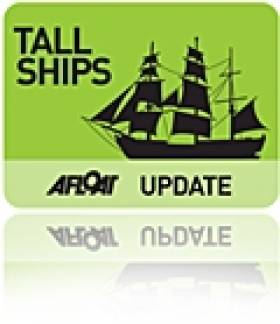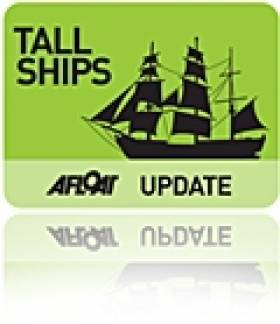Displaying items by tag: Dublin Tall Ships Parade of Sail
Last of the Tall Ships Finally Departs Dublin Port
#TALL SHIPS – It has been more than a fortnight ago since the spectacle of Dublin Tall Ships Race Festival's 'Parade of Sail' took place, and today the last participant, the Swedish Navy's Falken, made a southbound departure of Dublin Bay, writes Jehan Ashmore.
The last large tallship to depart the festival was the Italian Navy's Amerigo Vespucci, leaving the smaller Swedish gaff schooner to remain moored along the Liffey quays until her departure this afternoon. The B-class tallship built in 1947, is based out of Karlskrona and her crew of 13 officers and 29 trainees are currently heading for Porto.
It is ironic that on the same day of Falken's farewell, the Norwegian tallship Christian Radich is currently heading northbound in the Irish Sea as previously reported today. She is to visit the capital, where she called last year to publicise in advance this year's Tall Ships Race Festival.
Dublin Tall Ships ‘Parade of Sail’ Gun Salute Relocates from Dun Laoghaire Harbour to Poolbeg
#PARADE OF SAIL UPDATE– A gun salute for today's Dublin Tall Ship Festival climax of the 'Parade of Sail' will now take place at Poolbeg in Dublin Port, rather then Dun Laoghaire Harbour as previously reported, however the tallships will remain on a course to pass off the harbour entrance, writes Jehan Ashmore.
The first tallship to bid Dublin farewell, is to depart at 11.00 this morning, and once they pass the Poolbeg Lighthouse, they will then proceed on a course heading for Dun Laoghaire Harbour. Noting the first tallship is expected to pass off the harbour around 11.45am and the last ship is due around 2.15pm.
Awaiting the fleet in Dublin Bay will be the Naval Service OPV L.E. Emer (P21) which will be anchored north north-east (0.5miles) off the East Pier, Dun Laoghaire Harbour. The tallships will round pass the L.E. Emer and then change course by heading for the Dublin Bay Buoy in the centre of the bay and head for the Baily Lighthouse on Howth Peninsula.
There will vantage points throughout the coastline of Dublin Bay, with the South Wall in Dublin Port, the west and east piers of Dun Loaghaire Harbour and along Howth Peninsula, been particularly good locations to witness what should no doubt be a memorable day as these glorious ships of sail head off over the horizon to many a distant shore.
When the fleet arrives off Howth Peninsula, they will divide into two, as 11 tallships will gather to form a smaller fleet which are to take part in the inaugural Irish Sea Tall Ships Regatta. This new event sees these tallships racing between Dublin to Liverpool.
























